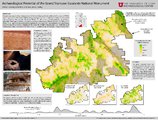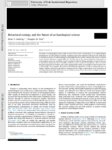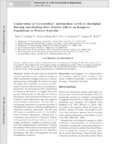Filters: Department: "Anthropology" School Or College: "College of Social & Behavioral Science" Collection: "ir_uspace" Format: "application/pdf"
| Creator | Title | Description | Subject | Date | ||
|---|---|---|---|---|---|---|
| 1 |
 |
O'Connell, James F. | A Different Paradigm for the Initial Colonisation of Sahul: Archaeological, genetic, demographic and geographic perspectives | The questions of when and how humans reached Sahul, the Pleistocene continent of Australia and New Guinea, has remained a central issue of Australian archaeology since its development as an academic discipline in the mid-twentieth century. Additionally, this has been a dominant theme linking Austral... | Sahul; Wallacea; colonisation; isolation; genomics; mitochondrial DNA | 2019-08-20 |
| 2 |
 |
Codding, Brian F. | A land of work: foraging behavior and ecology | Work is a core theme in many of the major issues and debates in California archaeology. Work is central in understanding why the first Californians entered the region (e.g., Erlandson, this volume): how thousands of years of work following colonization resulted in the overexploitation of particular ... | Human behavioral ecology; Hunter-gatherer; North America: California | 2012-03-15 |
| 3 |
 |
Codding, Brian | Alternative aboriginal economies: Martu livelihoods in the 21st century | In the western deserts of Australia, hunting and gathering endures as an important social and economic activity. That foraging persists within the boundaries of developed industrialized nation states may come as a surprise to those who evaluate foraging as less profitable than agricultural, wage or ... | Aboriginal economics; Aboriginal foraging | 2015 |
| 4 |
 |
Hawkes, Kristen | Alyawara plant use and optimal foraging theory | Various authors have remarked on the importance of seeds in the pre-European diet of central Australian Aborigines. The Alyawara, an Arandic-speaking group, were typical in this respect. They collected edible seeds from nearly half the eighty-five plant species in their traditional subsistence inven... | Australia; Aborigines; Foraging; Seeds | 1981 |
| 5 |
 |
Yaworsky, Peter M. | Archaeological Potential of the Grand Staircase-Escalante National Monument | Executive proclamation 9682 reduces the size of the Grand Staircase-Escalante National Monument (GSENM), removing protections for at least 2,000 known archaeological sites and an unknown number of undiscovered cultural properties. Because only 10% of the GSENM's 1.9 million acres has been inventorie... | Grand Staircase-Escalante National Monument; Anthropology-Research | 2018 |
| 6 |
 |
McElreath, Richard | Are peasants risk-averse decision makers? | For decades, researchers studying small-scale, subsistence-oriented farmers have sought to explain why these "peasants" seem slow to acquire new technologies, novel agricultural practices, and new ideas from the larger societies that have engulfed them. The early work on this question suggested that... | Subsistance farmers; Risk-aversion; Risk-taking; Cultural conservatism; Cost-benefit analysis | 2002 |
| 7 |
 |
O'Rourke, Dennis H. | Ascertainment bias for non-twin relatives in twin proband studies | When families are ascertained through affected twins, as for example when twin probands are selected from a registry and their non-twin relatives studied, a correction for ascertainment bias is needed. It is shown that probandwise counting (where relatives of doubly ascertained twin pairs are counte... | Genetic; Transmission; Models | 1982 |
| 8 |
 |
Rogers, Alan R.; Jorde, Lynn B. | Ascertainment bias in estimates of average heterozygosity | Population geneticists work with a nonrandom sample of the human genome. Conventional practice ensures that unusually variable loci are most likely to be discovered and thus included in the sample of loci. Consequently, estimates of average heterozygosity are biased upward. In what follows we descri... | Bias (Epidemiology); Biometry; Heterozygote | 1996-05 |
| 9 |
 |
Hawkes, Kristen | Assignment of relationship terms in Binumarien | Kinship systems have a perennial fascination. From Morgan's day to the present, a long succession of authors have produced their diagrams and algebraic explanations . . . Kinship terminology and its diagramatic arrangements provide, ready made, a delightful series of mathematical abstractions and it... | Binumarien; Binumariens | 1977 |
| 10 |
 |
Codding, Brian | Behavioral ecology and the future of archaeological science | The future of archaeological science relies as much (if not more) on theoretical as on methodological developments. As with anything in biology, explaining past human behavior will require the application of evolutionary theory. As with anything in archaeology, theory is useless without clear ties t... | 2015-01-01 | |
| 11 |
 |
Hawkes, Kristen | Binumarien color categories | This paper has two aims. The first is to describe an ethnographically new system of color classification, Binumarien, a non-Austronesian or Papuan language of the Eastern Central Highlands of New Guinea2. In this connection we are particularly interested in relating our data to the Berlin and Kay (1... | Binumarien; Binumariens | 1975 |
| 12 |
 |
O'Rourke, Dennis H. | Biochemical heterozygosity and morphologic variation in a colony of papio hamadryas hamadryas baboons | This analysis examines the association between genetic heterozygosity and individual morphologic variation in a captive population of Papio hamadryas hamadryas consisting of 403 juveniles and adults. The population structure of the colony was artificially generated and maintained and is thus rigoro... | Population genetics; Polygenic; Inbreeding | 1994 |
| 13 |
 |
McElreath, Richard | Can females gain additional paternal investment by mating with multiple males? a game theoretic approach | Although females may require only one mating to become inseminated, many female animals engage in costly mating with multiple males. One potential benefit of polyandrous mating is gaining parental investment from multiple males. We developed two game theoretic models to explore this possibility. Our... | Female multiple mating; Polyandry; Nonprocreative mating; Paternal investment; Mating benefits; Mating strategy | 2001-11 |
| 14 |
 |
Broughton, John | Cathedral cave fishes | Table XLI provides the numbers of identified fish specimens by element from Stratum II at Cathedral Cave. The criteria used to arrive at those identifications are provided in chapter nine. A total of 547 identified fish specimens are represented in this deposit; all of those are sculpin. The mottled... | Homestead Cave; Ichthyofauna; Lake Bonneville | 2000 |
| 15 |
 |
Codding, Brian | Codding, Brian: Living outside the box: An updated perspective on diet breadth and sexual division of labor in the Prearchaic Great Basin [Author's Manuscript] | A tremendous amount has been learned about the Prearchaic (before 9000 BP) Great Basin since we advocated a perspective of sexual division of labor based on Human Behavioral Ecology a decade ago. Many investigators have taken our advice and a few have challenged our assumptions and inferences. One o... | 2014-01-01 | |
| 16 |
 |
Cashdan, Elizabeth A. | Competition between foragers and food producers on the Botletli River, Botswana | The immigration of food-producing groups into areas occupied by hunters and gatherers must have been a common occurrence in prehistory. How were the hunter-gatherers affected by this? I describe here two groups of Kalahari Basarwa ('Bushmen'), one living along the flood plain of the lower Botletli ... | Kalahari Basarwa; Bushmen; Foraging; Cattle | 1986 |
| 17 |
 |
Codding, Brian | Conservation or co-evolution? Intermediate levels of aboriginal burning and hunting have positive effects on kangaroo populations in Western Australia | Studies of conservation in small scale societies typically portray indigenous peoples as either sustainably managing resources, or forsaking long-term sustainability for short-term gains. To explain this variability, we propose an alternative framework derived from a co-evolutionary perspective. In ... | 2014-01-01 | |
| 18 |
 |
Harpending, Henry C.; Jorde, Lynn B. | Culture creates genetic structure in the Caucasus: autosomal, mitochondrial, and Y-chromosomal variation in Daghestan | Near the junction of three major continents, the Caucasus region has been an important thoroughfare for human migration. While the Caucasus Mountains have diverted human traffic to the few lowland regions that provide a gateway from north to south between the Caspian and Black Seas, highland populat... | Caucasus; Haplogroups; Autosomal variation; Mitochondrial variation; Y-chromosomal variation; Endogamy; Avar; Dargin; Kubachi; Culture | 2008 |
| 19 |
 |
Harpending, Henry C.; Rogers, Alan R. | Detecting positive selection from genome scans of linkage disequilibrium | Though a variety of linkage disequilibrium tests have recently been introduced to measure the signal of recent positive selection, the statistical properties of the various methods have not been directly compared. While most applications of these tests have suggested that positive selection has pl... | Genome scans; Linkage disequilibrium; Gene trees | 2010 |
| 20 |
 |
Rogers, Alan R. | Doubts about isonymy | The method of isonymy, developed by Crow and Mange for estimating inbreeding from surname frequencies, requires an assumption that has not been appreciated: It is necessary to assume that all males in some ancestral generation, the founding stock, had unique surnames. Because this assumption is sel... | 1991 | |
| 21 |
 |
Bell, Adrian | Driving factors in the colonization of Oceania: developing island-level statistical models to test competing hypotheses (Electronic Supporting Material) | To test the model specification and fitting algorithms, we simulated data using randomly generated parameters, settlement chronology, and accessibility matrix for N islands. Using the function optim in R, we found the maximum likelihood estimates and compared them with the "true" parameter values us... | Oceania; Archaeology; Settlement; Statistical models | 2015-01-23 |
| 22 |
 |
McElreath, Richard | Economic man in cross-cultural perspective: behavioral experiments in 15 small-scale societies | Since "Selfishness examined . . ." (Caporael et al. 1989) appeared in these pages, more than 15 years ago, many additional experiments have strongly confirmed the doubts expressed by Caporael and her collaborators concerning the adequacy of self-interest as a behavioral foundation for the social sci... | Economic outcomes; Selfishness; Fairness; Reciprocity | 2005 |
| 23 |
 |
Codding, Brian F. | Environmental productivity predicts migration, demographic, and linguistic patterns in prehistoric California | Global patterns of ethnolinguistic diversity vary tremendously. Some regions show very little variation even across vast expanses, whereas others exhibit dense mosaics of different languages spoken alongside one another. Compared with the rest of Native North America, prehistoric California exemplif... | Colonization of North America; Prehistoric migrations; Human behavioral ecology; Ideal free distribution; Ideal despotic distribution | 2013-09-03 |
| 24 |
 |
Cashdan, Elizabeth A. | Ethnocentrism and xenophobia: a cross-cultural study | Analyzes the factors influencing ethnic affiliation and interethnic hostility. Relationship between intraethnic loyalty and risk of famine; Continuity of violence at different levels of groupings; Analysis of local and intercommunity conflict. | Ethnic relations; Ethnology | 2006-06-06 |
| 25 |
 |
McCullough, John M. | Evidence for assortative mating and selection in surnames: a case from Yucatan, Mexico | Surnames are often used as metaphors for genetic material on the assumption of neutrality and general immunity from systematic pressures. The Yucatec Maya use surnames of both Maya and Spanish origin. We find evidence of positive assortative mating by ethnic origin of surname and a slight bias away ... | Surnames; Assortative mating; Maya | 1985 |
